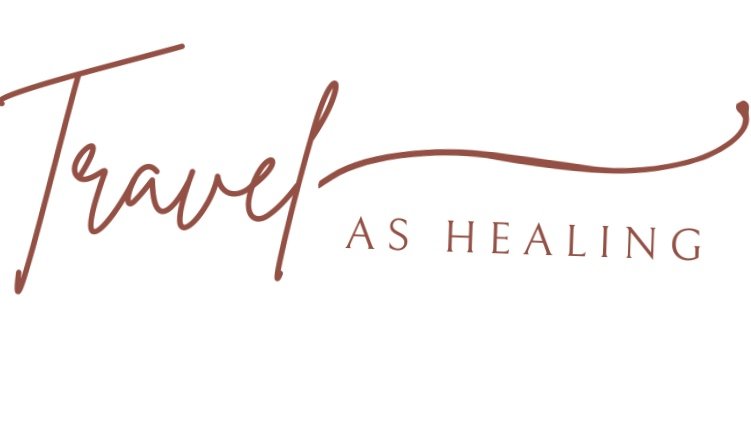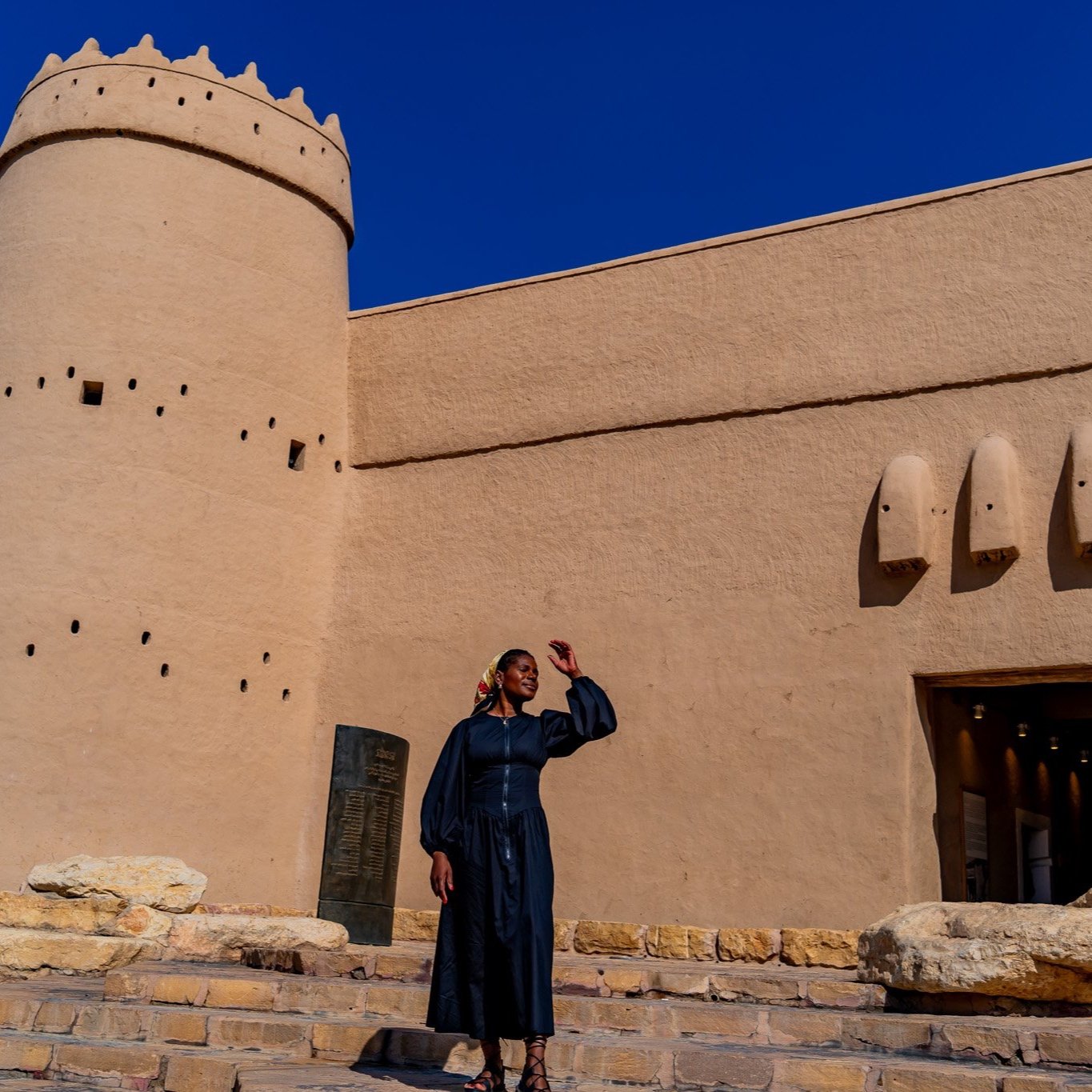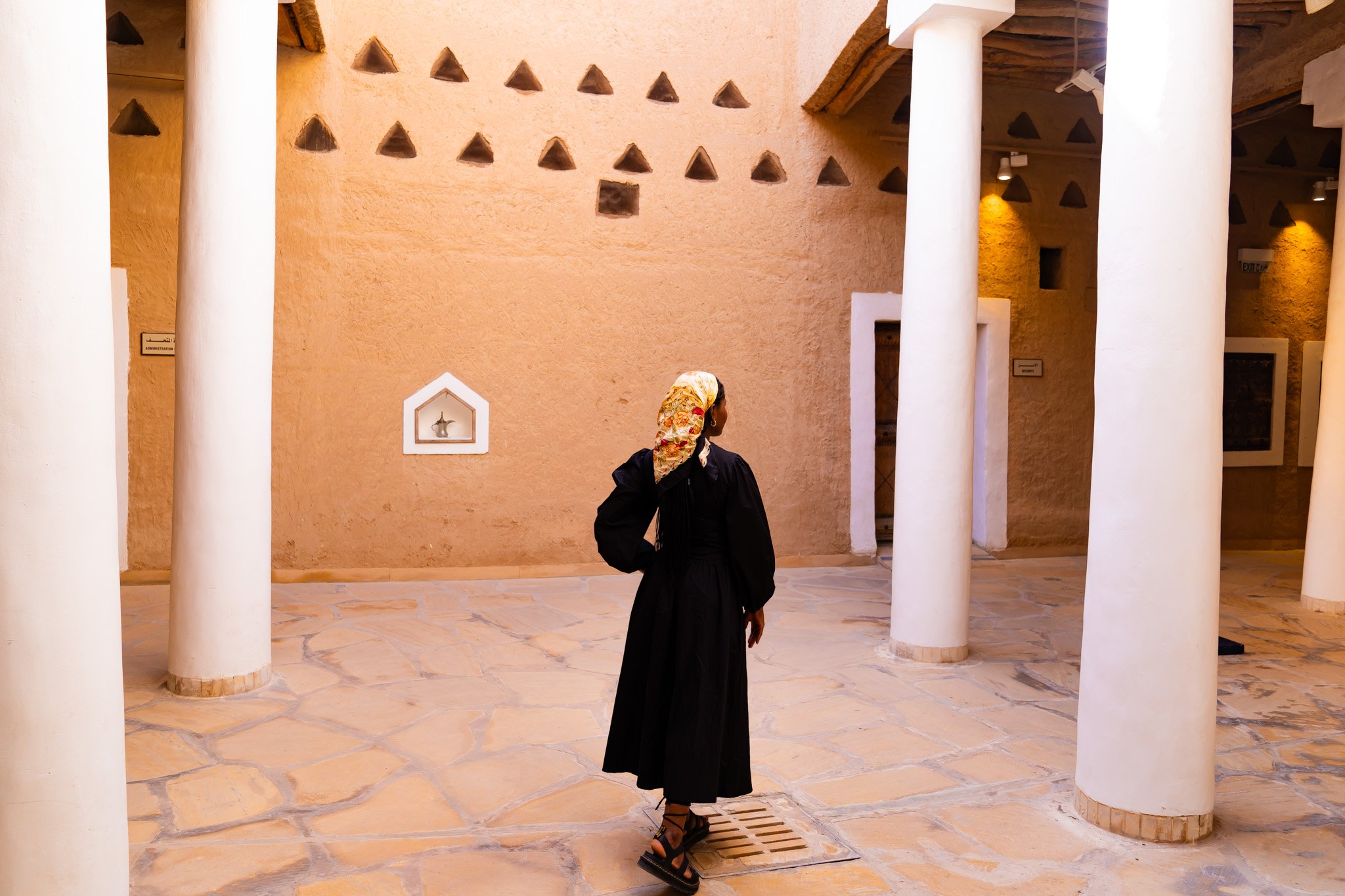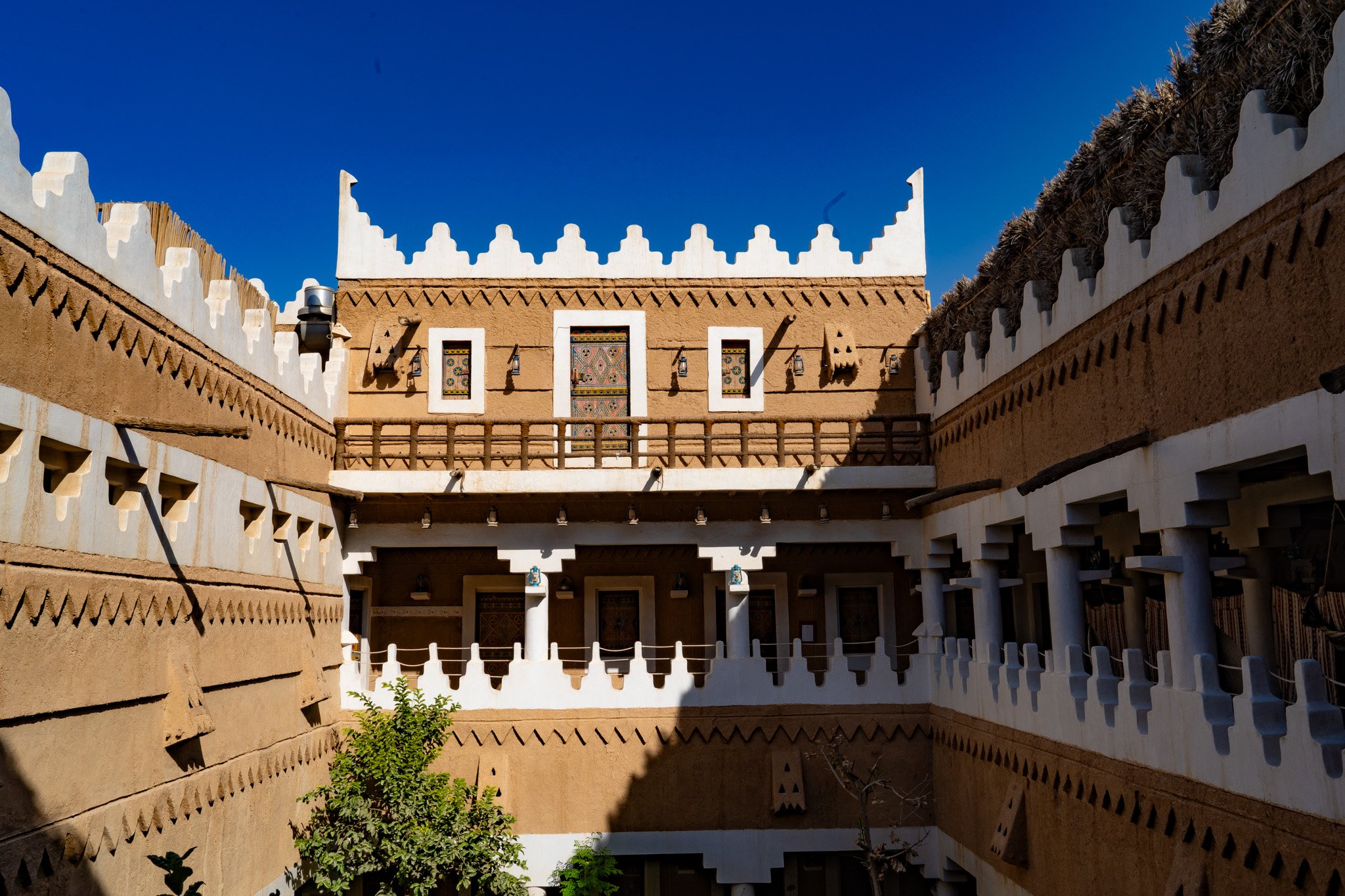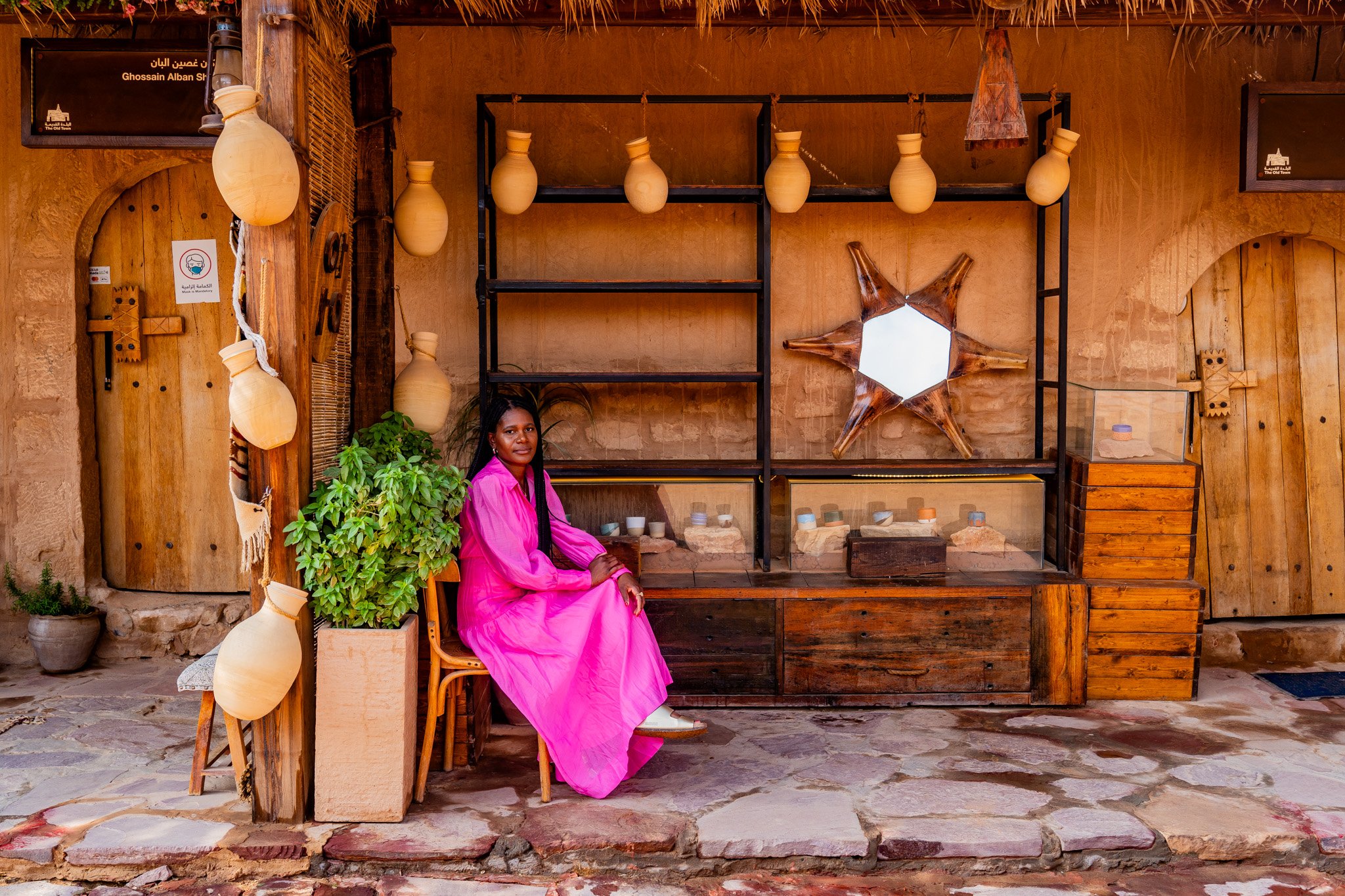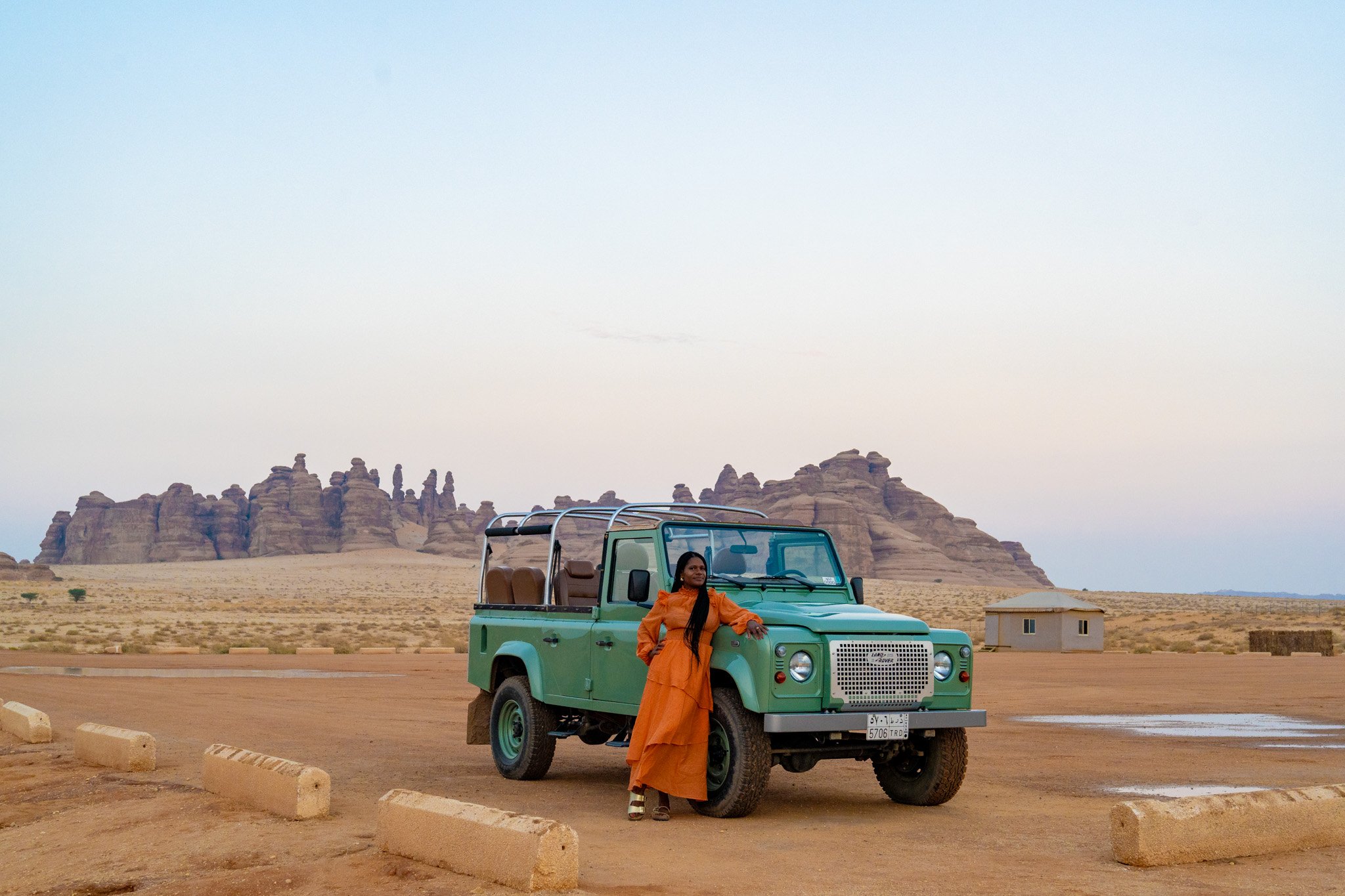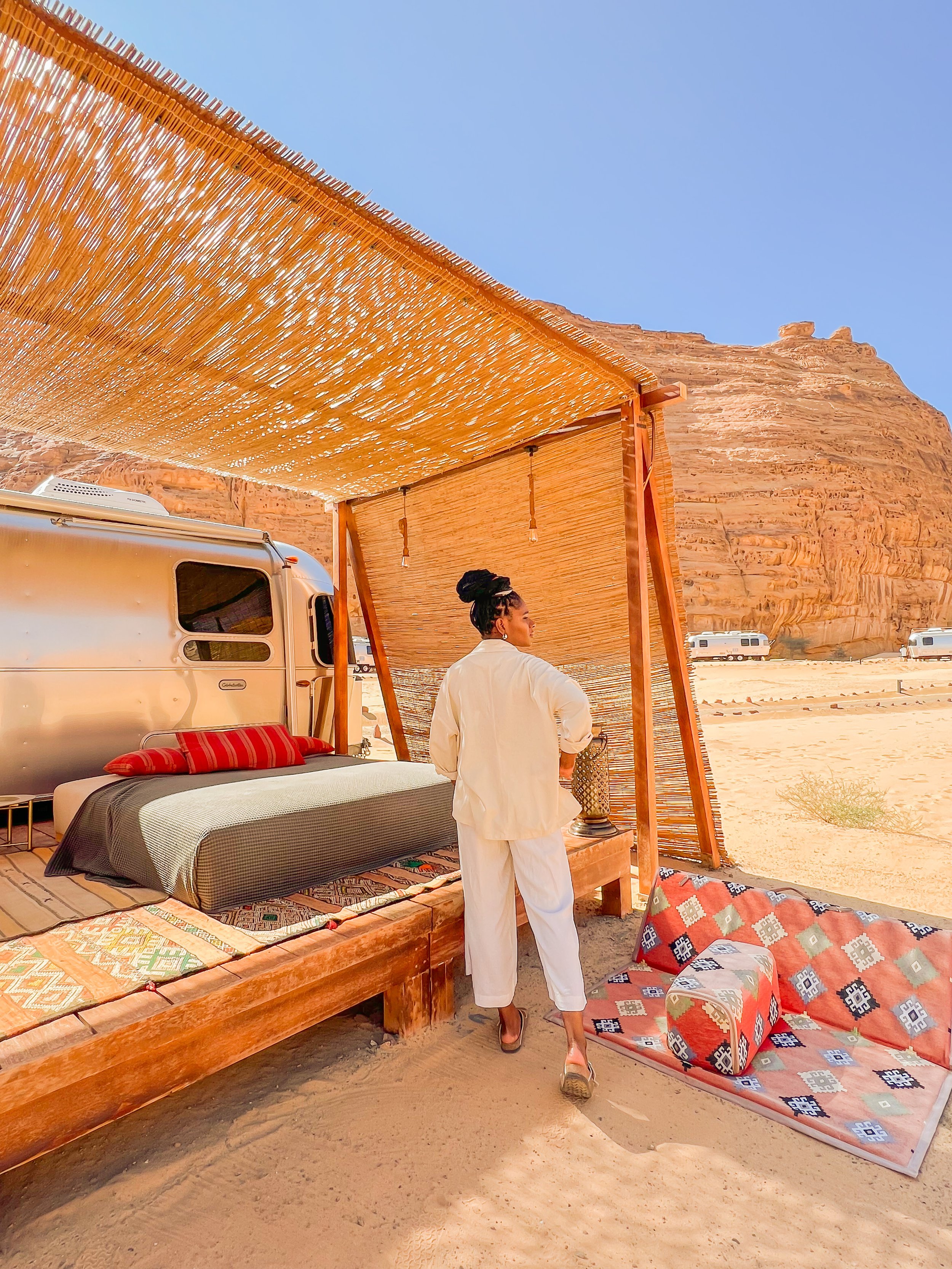A Travel Guide to Saudi Arabia
Al Masmak Museum, Riyadh, Saudi Arabia
I had yet to learn a 14-hour layover in Doha would lead me back to the Middle East. One week before the world shut down in 2020, I was sandboarding and chasing sunset in Qatar. As the sun set, I remember my tour guide pointing towards a silhouette of Saudi Arabia in the distance. I thought then, I'd never travel to the Kingdom of Saudi Arabia (KSA), but as the saying goes, never say never.
As recently as 2019, tourists were forbidden from traveling to Saudi Arabia unless they identified with Islam religion and were visiting Mecca for Umrah or were traveling for business. Although KSA has the largest economy in the Arab States and is the world's largest petroleum and natural gas producer, the Kingdom is moving drastically towards a more balanced economy with a plan to invest trillions of US dollars in its tourism sector. The monarch committed to climate change Vision 2030 and is taking drastic measures to reduce their carbon footprint and reliance on oil. According to the World Economic Forum index, in just two years, KSA moved from the 43rd to 33rd country on the list because of improvements made across almost all indicators. Their plan is working.
Over the last year, I challenged myself to lead a life of curiosity, which forced me to ask better questions about myself, others, and the world I inhabit. A prerequisite to asking better questions is setting my assumptions and biases aside and leaning into presence, compassion, and connection. When I learned the Kingdom opened its borders to globe trotters like me, this maxim also applied to KSA, regardless of what I had seen on my television screen or read online. I wanted to see. Before visiting, I examined my thoughts and big feelings towards a country whose history is long and deep, rich and complicated, especially on the human rights front. I booked a flight, spent five minutes applying for a visa, and in less than fifteen minutes, I received an approval confirmation. I was on my way to KSA!
Old Town Al-Ula, Saudi Arabia
Is Saudi Arabia Safe?
In 2016, the Kingdom stripped the morality police (Mutawa) of their power to patrol public spaces and arrest people because of strict religious standards. In light of this, women can now drive, uncover their hair in public, or choose not to wear abayas. My little cousin joined me on the trip, and we visited Riyadh and AlUla. KSA people were warm, welcoming, helpful, and friendly. Like most countries, we felt safe. I have traveled to more than thirty countries, mostly solo, so I would also run the risk of saying that even if I had traveled to Saudi Arabia alone, I still would have felt safe. I do recognize that safety is relative, and although the moral and religious police were stripped of their rights, I would still caution my LGBTQ+ friends to be cautious traveling there given the oppressive laws that still exist today for same-sex couples.
Al Masmak Museum, Riyadh, Saudi Arabia
Things to know before traveling to Saudi Arabia
Travel is often a cultural exchange that is mutual, respectful, genuine, and intentional. Still, sometimes, we visit foreign places expecting people to adapt to our way of living. Be mindful not to make that mistake in KSA. The Kingdom has several rules that you should consider before visiting, some of which are relatively straightforward. A general rule of thumb is if you don't do it in your home country, don't do it abroad.
Visa: A visa to the Kingdom is available for 49 countries, and if you're traveling from the United States, you can apply for an e-visa before arrival for USD 143. A standard passport photo, flight, and hotel arrangements are required for the application.
Where to go: Saudi Arabia is divided into five regions, and the country's landscape is breathtaking. To maximize your time, narrow down the cities you want to visit. Some of the more progressive cities travelers frequent are Riyadh, Jeddah, Al-Ula, and Mecca. However, non-Muslims are prohibited from visiting the mosque in Mecca. When it comes to booking tours, I learned that many of the tour companies are still figuring out where they fit in KSA tourism right now and they’re doing a ton of research to ensure they’re ready for the real tourism boom. You’ll find few tours on popular websites like Viator and Get Your Guide, but I learned the hard way that tour companies are still figuring it out. I recommend checking out Saudi Tourism websites to get an idea of what’s available in the country and purchasing your tickets directly with them for a better experience. However, be sure to do your research. Some long day trips will require a tour and other places you can hire a taxi for the day.
Getting around & tours: You'll still find plenty of gender segregation in public places (gyms, malls, airports), but the Kingdom is making many enhancements to its systems and infrastructure. The ease of commuting can vary based on the city. In Riyadh, it was easy to use apps like Uber or Careem; in AlUla, Kaiin was unreliable, and AlUla taxis were fine. I'd recommend asking your hotel for the best options for getting around and asking them what a reasonable cab fare is for your trip. Alternatively, I learned from another traveler that renting a car with an international license is relatively easy.
Dress code: Women are required to dress modestly; wearing the hijab/abaya and covering your hair is not mandatory, but be mindful to wear loose clothing that covers the knee, chest, and elbow.
Public violations: The Kingdom may be open, and the moral police may be disbanded, but measures are still in place to ensure that the country remains conservative. To name a few, public display of affection, littering and spitting in public, occupying seats designated for the elderly/disabled, bypassing barriers to access public areas, wearing improper clothing, and taking pictures or videos of people and incidents without permission can all result in a fine of 200 - 1000 Riyals (SAR)
View from Sky Bridge Tower, Riyadh, Saudi Arabia
36 hours in Riyadh
3:00 am - I arrived in Riyadh, and to my surprise, the line to the immigration counter was not segregated by gender as I had imagined. I looked on as many South East Asians and Africans got their passports stamped, and when it was my turn, I greeted the officer, "Salam Alaikum," as I handed over my e-visa and passport. There were minimal verbal interactions, and I kept thinking about how I never imagined the Kingdom of Saudi Arabia would be my thirty-first country, but here I am. I made my way to baggage claim, and to my dismay, my luggage from Egypt never made it to Saudi Arabia.
5:30 am - I'm still at Riyadh International Airport, hoping to get information about my missing luggage. I messaged my tour guide to inform him I needed to cancel my tour to Ushaiqer Village. Ushaiquer is one of the oldest ancient villages in Shagra, a city about 200 kilometers from Riyadh. The town is known for its red mud-brick houses, date palm trees, and fresh spring water. Many pilgrims journeying to Mecca from Kuwait stopped in the ancient city to rest. Unfortunately, I could not visit during this time, but I hope to return on my next visit.
My trip started with a speed bump, but if there is one thing I know for sure, travel will teach you how to pivot quickly amid triggers, frustration, and unforeseen circumstances. I was tired but felt alive and excited to enjoy the rest of my time in Saudi Arabia. Later that day, my luggage arrived, and I was ready to hit the road.
9:00 am - There are about 6 UNESCO ancient heritage sights in various regions nationwide. These places carry secrets and mysteries of the old Arab state and its Nabatean people, so I hopped in a taxi to visit Saudi Arabia's first state, the ancient town of Diriyah. Diriyah is a UNESCO site located twenty minutes from Riyadh. Upon arrival, I noticed the main roads were blocked by local security—so many disappointments in the last 24 hours! Although KSA is open for tourism, several development projects are still underway. Unfortunately, the websites were misleading during my visit, and many heritage sites were closed as significant improvements are being made to attract tourism in 2024 and beyond. Yet, another hiccup, but perhaps by the time you visit, the construction would be done by then. Nonetheless, add this to your list!
10:30 am - From Diriyah, getting another taxi to the Al Masmak Museum in the old city was nearly impossible due to road closures. Al Masmak is a free museum and is a crucial landmark representing the unification of Riyadh to Saudi Arabia. The fortress is divided into six quarters, and I did a self-guided tour to learn about its history. It’s not a huge museum, but I was learning so much and stayed way longer than I anticipated.
Al Masmak Museum, Riyadh, Saudi Arabia
Al Masmak Museum, Riyadh, Saudi Arabia
Al Masmak Museum, Riyadh, Saudi Arabia
Al Masmak Museum, Riyadh, Saudi Arabia
1:00 pm - I got a taxi to the new city, and Cafe Bateel was my first stop for lunch. That day, Saudi won the worldcup against Argentina, and it was a delight to see everyone full of glee, people adorned in abayas waving KSA colors and flag — it was a motorcade. I stood outside Olaya Street and watched people come from everywhere to celebrate loudly and proudly, honking and shouting, chanting and waving their flags. That day, Olaya Street was filled with jubilee. I decided to walk the entire street, visit he mall, sit at another cafe to people watch before trekking to another landmark, Kingdom Tower.
Celebration on Olaya Street, Riyadh, Saudi Arabia
Kingdom Tower in the distance
5:00 pm - Kingdom Tower is one of Riyadh's tallest buildings and the largest mall. On the 97th floor is the Sky Bridge, and I paid about $18 for an entry ticket. The panoramic view of the city was worth every penny. I sat there until sunset, and the patriotic green lights lit up the city in honor of the KSA win against Argentina. It was an acknowledgement for the city reveling in jubilee and while the trip started out rough, I too, felt a sudden rush of happiness all around.
Kingdom Tower, Riyadh, Saudi Arabia
6:00 pm - At the recommendation of a security officer, I got a taxi from the Sky Bridge to Boulevard City to continue the celebration. Boulevard City was extremely crowded and it felt like Times Square meets amusement park giving Riyadh a modern and vibrant feel and it’s where all the cool people seem to hang out. You’ll need to pay 100 SAR and pass through security detectors before entering Boulevard World. It’s worth a visit if you plan to shop or you just want to see another side of Riyadh.
Skybridge Tower, Riyadh, Saudi Arabia
Skybridge Tower, Riyadh, Saudi Arabia
Boulevard City, Riyadh, Saudi Arabia
Noon: It's my last day and KSA declared a public holiday because they won the world cup. I've been traveling for two weeks, so I slept late before heading to Najd Village Heritage for lunch. Najd restaurant is where the locals frequently go for lunch. The Downstairs is open and the designated eating space is along the corridors. The upstairs is closed with curtains for those who want to enjoy their meal in private, mostly families. The sitting quarter was carpeted so I sat on the floor like a local to enjoy my meal. I had a variety of traditional dishes, rice and lamb cooked in a pressure steam pot, fried brown bread, cheese sambosa and laban and mint tea. It was a good way to end my time in Riyadh.
Najd Village Heritage Site, Riyadh, Saudi Arabia
Najd Village Heritage Site, Riyadh, Saudi Arabia
Traditional Lunch at Najd Village Heritage Site: Rice and lamb, fried brown bread, cheese sambosa and laban and mint tea
Najd Village Heritage Site, Riyadh, Saudi Arabia
48 hours in Al-Ula
The ancient city of AlUla opened its borders to international travelers in 2020. AlUla is located in the northwestern region of Saudi Arabia. It is one of the oldest regions in the Arabian Peninsula with a history of human activity from the Lihyan, Dadan, and Nabatean Kingdoms.
Old Town AlUla, Saudi Arabia
8:00 pm - I arrived at the newly built local airport and was welcomed with the sweet sound of live Arabic music in the lobby of the tiniest airport. We received our bags about five minutes after landing (praise be!), and drove forty-five minutes to the sustainable and eco-friendly hotel in Ashar Valley, Habitas AlUla.
7:30 am - I received a text from my driver, and within thirty minutes, we made it to the Old Town. This activity started with walking down the historic Incense Road, where merchants from neighboring regions passed through the old town with frankincense, myrrh, other goods and textiles en route to the market in Mecca. The tour started at 9:15 am, and about four other travelers joined. We were each served with local coffee and dates. In the Old Town, over 900 ancient homes are currently under restoration as the Kingdom is trying to preserve the local heritage and attract new visitors to AlUla. I strolled through the tiny alleys, and as I walked past the mud-brick homes built some 700 years ago, it felt like I was in a time machine.
10:30 am - The tour ended, and we drove off the beaten path to Pink Camel for a delicious brunch.
Old Town AlUla, Saudi Arabia
Old Town AlUla, Saudi Arabia
Old Town AlUla, Saudi Arabia
Old Town AlUla, Saudi Arabia
Old Town AlUla, Saudi Arabia
Old Town AlUla, Saudi Arabia
Old Town AlUla, Saudi Arabia
Old Town AlUla, Saudi Arabia
Old Town AlUla, Saudi Arabia
Noon - I returned to the hotel to relax, hang out by the caravan park, play table tennis at the caravan tent, and connect with locals who work there.
4:00 pm - I headed to Winter Park, the meeting spot for my vintage tour of Hegra and later Hegra After Dark, for an immersive multi-sensory tour experience and it was was an immaculate open air theatrical reenactment of the Nabatean story. Similar to Petra's ancient world wonder, the monuments at Hegra are sandstone tombs carved by the Nabateans, and one of the tombs was declared Saudi Arabia's first UNESCO site. In AlUla, the Nabateans grew wheat, barley, dates, and pomegranate and they understood that water creates life but erodes stone. As such, they were also engineers, masters of water, artists, and traders. They built channels and constructed large systems to store and move water to farms and believed that the carved tombstones were not just monuments because women and men commissioned them to show the value and importance of communal living.
Vintage Tour to Hegra. AlUla, Saudi Arabia
Vintage Tour to Hegra. AlUla, Saudi Arabia
Vintage Tour to Hegra. AlUla, Saudi Arabia
Vintage Tour to Hegra. AlUla, Saudi Arabia
Vintage Tour to Hegra. AlUla, Saudi Arabia
8:00 pm - I ended the day with a sound healing session and dinner at Tama restaurant in Habitas AlUla, and later that night, I slept under the stars on a decorated mattress outside the caravan.
AlUla felt like an open-air museum. The landscape is bold, abstract, inviting, and aesthetically pleasing. I often walk away feeling full, relaxed and inspired in a place like that. After traveling for two weeks, it felt like the place I needed to wind down, so on my second day, I did nothing but enjoyed the resort.
Caravan, Habitas AlUla
Habitas AlUla
Hegra After Dark
Hegra After Dark
Hegra After Dark
Hegra After Dark
7:30 am - It was my last day and I didn’t wake up early enough to catch the sunrise. Nonetheless, I hopped on an e-bike and rode around the Habitas AlUla. The resort provided an immersive and adventurous experience so I played on the swings, hung out by the pool, biked some more, jumped on the trampoline, and worked up a big enough appetite before breakfast at Tama. These activities may seem ordinary, but doing them surrounded by these majestic and naturally sculpted rocks elevated the experience.
Caravan, Habitas AlUla
Caravan, Habitas AlUla
Caravan, Habitas AlUla
1:00 pm - I decided I wanted to visit The Maraya. It is the largest mirrored building on earth and a concert venue where the likes of Mariah Carey, Alicia Keys, and John Legend performed a few weeks before my visit. This building is also located in Ashar Valley, only ten minutes from the hotel. Still, pedestrians are not allowed to walk in the valley. The Maraya is nearly camouflaged in the middle of the desert because it reflects the valley's majestic rock formations and palm trees. I was not allowed to enter the building as preparations were underway for another concert later that day.
2:00 pm - With little time to spare, I asked the taxi driver to stop by Okto. Okto is a Greek cuisine restaurant located on the top of a black mountain, and it was highly recommended by locals as having the best view in the city overlooking Harrat. There are conversation lounge seats with fire pits all around to make it worthwhile and relaxing. If time permitted, I would have definitely spent more time here because this place was a delight and while I cannot vouch for the food, Greek cuisine is my favorite.
Habitas AlUla
Habitas AlUla
The Maraya, AlUla, Saudi Arabia
The Maraya, AlUla, Saudi Arabia
Okto, AlUla Saudi Arabia
3:00 pm - I am late for checkout. I rushed back to the hotel to freshen up, grab my bags, and leave for the airport and on my way, I stopped at Jabal Alfil, also known as Elephant Rock because its geological formation took the shape of an elephant, but this place is more of a free and open park where local people can hang out. There were several foodtrucks to order from and many giant bean bags and conversation pits to relax and enjoy my final hours in Saudi Arabia.
Jabal Alfil - Elaphant Rock, AlUla, Saudi Arabia
Jabal Alfil - Elaphant Rock, AlUla, Saudi Arabia
Curiosity led me to KSA and I'm glad I said yes to indulging in its rich heritage and stunning landscape. There is so much I did not get to do/see, and a lot will change in the coming years so maybe I’ll visit again. If you're considering to visit right now, I’ll recommend waiting another year or three. Saudi Arabia will look and feel different with the Red Sea project and the construction of the world's largest central park coming to Riyadh in the next five years.
